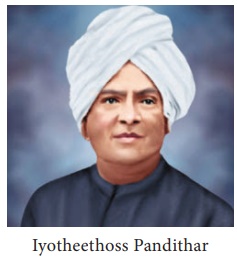Towards Modernity - Reform Movements in Tamilnadu | 11th History : Chapter 19 : Towards Modernity
Chapter: 11th History : Chapter 19 : Towards Modernity
Reform Movements in Tamilnadu
Reform Movements in Tamilnadu
As we saw earlier, the reform movements of the
north India had its own impact on Tamilnadu. Brahmo Samaj and Arya Samaj had
their branches. Keshab Chandra Sen visited Madras and lectured here. But
Tamilnadu also saw its own reform movements.
Vaikunda Swamigal (1809-1851)

The Sri Vaikunda Swamigal’s cult, which survives to
this day, was organized in the 1830s. Born in a poor family (1809) at
Sastankoil Vilai (now known as Swamithoppu), a village then in south Travancore
(the present day Kanyakumari district), Muthukutti, spent his childhood in the
village pial school, learning
religious and moral texts. He also learnt the Bible and became well -versed in
Christian theology. At the age of twenty two, Muthukutti, cured of a skin
disease, after a holy bath in the sea during his visit to the Murugan temple at
Tiruchendur (Thoothukudi district), claimed that Lord Vishnu had given him a
rebirth as his son. On his return from Tiruchendur, assuming the new name of
Sri Vaikundar, he practised austerities for two years. Soon his fame spread far
and wide.
In his preaching Vaikundar attacked the traditional
caste-ridden Travancore society and its ruler for collecting excessive taxes
from the lower caste people. He was arrested and jailed by the Raja of
Travancore for his “seditious speeches”. When he was released from jail (1838)
he became more popular among the people. His followers called him Aiya (father) and his cult came to be
known as Aiya Vazhi (path of the father). His teachings were compiled as a text
called Akila Thirattu which is
recited religiously to this day.
Vaikunda Swamy instructed his followers to give up
worship of pudams. He also exhorted them not to offer animal sacrifices to
their deities. He advocated vegetarianism.
As a symbol of protest, Vaikunda Swamy urged his
followers to wear a turban, a right which was permitted only to upper castes in
those days. As a part of his effort to practice equality, Vaikunda Swamy
regularly organized inter-dining through his Samathuva Sangam, among different
castes. In his feeding centres called Nilal Tangals, caste-based restrictions
were broken down. The Vaikunda Swamy cult posed a serious challenge to the
spread of Christianity in south Travancore even after his death in 1851.
Vallalar Ramalinga Swamigal (1823–1874)

Ramalinga Swamigal was born in a modest family near
Chidambaram and spent his early life in Madras. He never had formal schooling,
but exhibited great scholarship. Inspired by the Saiva Thevaram and
Thiruvasagam hymns, he began to compose moving poems on his own. In his time,
Saiva religion was in the grip of Saiva monasteries such as those at
Thiruvaduthurai, Dharumapuram and Thiruppanandal. Ramalinga Swamigal’s poems
expressed radical ideas and condemned bigotry and irrationality. He underwent
certain mystical experiences which he expressed in his poems. This was resented
by the orthodox elements in Saiva religion. He established the Sathya Dharma
Salai at Vadalur where he began to feed poor people, especially in the context
of the 1860s famine and pestilence, irrespective of caste and creed. He founded
the Sathya Gnana Sabhai to organize his followers. This brought him into
conflict with established Saivite orders, and matters came to a head when his
followers published his poems under the title of Thiruvarutpa (Songs of Grace) in 1867. Orthodox Saivites under the
Sri Lankan reformer Arumuga Navalar criticized this as blasphemous and launched
a tract war. But ultimately, Ramalinga Swamigal’s contribution was recognized
and his writings inspired universal ideas, and undermined sectarianism in Saiva
religion.
Buddhist Revivalism and Iyotheethoss Pandithar (1845-1914)

As we saw in an earlier lesson, Buddhism had been
practically wiped out in the Tamil country by the beginning of the second
millennium. Towards the end of the nineteenth century, there was a revival of
Buddhism. The publication of the complete edition of Jeevaka Chintamani (1887)
and Manimekalai (1898) were landmarks in the recovery of heterodox traditions.
But the most important figure was Iyotheethoss Pandithar (1845– 1914). A native doctor by profession, he was an erudite scholar. He also came under the influence of Colonel Olcott of the Theosophical Society. In the 1890s he began a movement among the Adi Dravidars arguing that they were the original Buddhists who had been consigned to ‘untouchability’ due to their opposition to Vedic Brahminism. He re-read classical Tamil and other texts to make his case. He also encouraged the conversion to Buddhism. He found the greatest following in north Tamilnadu and among the working classes of the Kolar Gold Fields. In this movement, M. Singavelu and Prof P. Lakshmi Narasu also played an important role. Pandithar ran a weekly journal called Oru Paisa Tamilan (later Tamilan) from 1908 until his death.
Related Topics